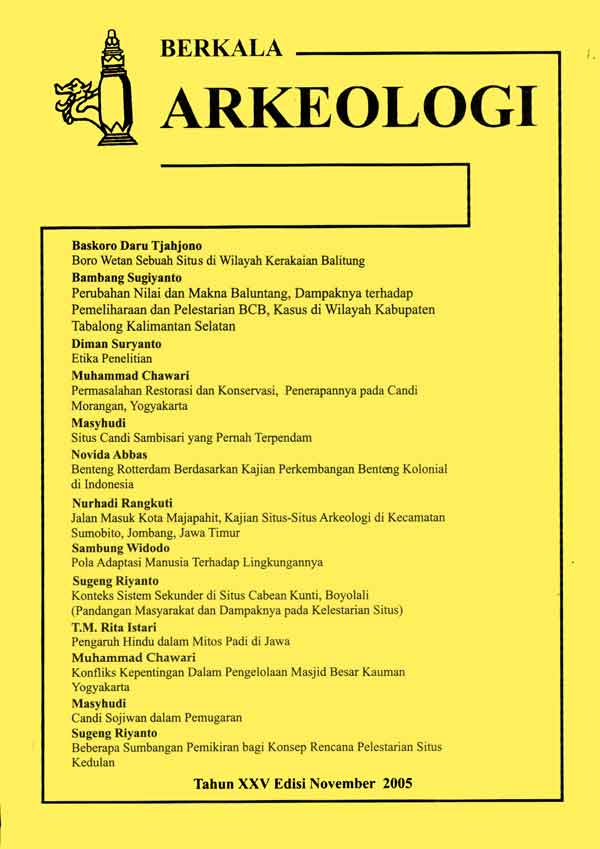SITUS CANDI SAMBISARI YANG PERNAH TERPENDAM
Main Article Content
Abstract
Geomorphologically, Sambisari Temple site is located on the alluvial plain at the foot of Mount Merapi, so that the land is fertile, it is easy to get water and the land is suitable for living and farming. This reason is very possible for the construction of temples. However, because then the area where the site was covered by volcanic ash as a result of the eruption of Mount Merapi which was very powerful due to the combination of the three tectonic, gravitational and volcanic forces that caused the volcanic cone of Merapi to flow sunken hyperbolic faults. This results in the level of soil fertility around the Sambisari Temple Site decreasing and even becoming damaged, because based on the soil material the sediment comes from the main material of lava deposits and fluvial deposits resulting from cleavage of pyroclastic materials from the eruption of Merapi Volcano in the form of boulder, gravel, sand, and dust. While the development of the soil around the Sambisari Site is still in the initial stage which is a type of horizon regosol soil and this soil has not experienced horizon differentiation, so that the soil profile is homogeneous. Such soil properties can be observed through the texture of dusty sand to gravel dust.
Article Details

This work is licensed under a Creative Commons Attribution-NonCommercial-ShareAlike 4.0 International License.
References
Fannekoek, A.j. 1949. Out line of the Geomorphology of Java. (Alih bahasa: Basri, Budio, 1989). Garis Besar Geomorfologi Pulau Jawa.
Anonim. 1989. Pemugaran Candi Brahma Prambanan, Candi Sambisari, Taman Narmada, Departemen Pendidikan dan Kebudayaan, Jakarta.
Bemmelen, R.W. 1970. The Geology of Indonesia, Vol. IA General Geology of Indonesia and Adjacent Archipelagoes, edisi ke-2. The Hague-Martinus Nijhoff.
Damon, Albert. 1977. Human Biology and Ecology. W.W. Norton and Company, New York.
Hardesty, Donald L. 1980. The Use of General Ecological Principles in Archaeological. Dalam M.B. Schiffer Advances in Archaeological Method and Theory.
Ibnu Thufail, Fajar. Pendekatan Lingkungan dalam Teori Kebudayaan. Media Komunikasi Artefak, No. 14. Yogyakarta.
Kusumohartono, B. M. (1985). Pendekatan Lingkungan Dalam Rekonstruksi Pertumbuhan Pemukiman Trowulan Kuna: Suatu Pemikiran Induktif. Berkala Arkeologi, 6(1), 56–66. https://doi.org/10.30883/jba.v6i1.436
White, Leslie A. 1959. The Evolution of Culture. Mc. Graw Hill Co, New York.
Lombard, Denis. 2000. Nusa Jawa Silang Budaya, Vol. 1, Batas-Batas Pembaratan. Gramedia Pustaka Utama, Jakarta.
Steward, Julian, H. 1955. Theory of Cultural Change: The Methodology of Multilinier Evolution. Urbana University of Illinois Press.
Mc. Naughton, S.J. dan Wolf, Larry L. 1990. Ekologi Umum. Gadjah Mada University Press, Yogyakarta.
Mundardjito. 1993. Pertimbangan Ekologi dalam Penempatan Situs Masa Hindu-Budha di Daerah Istimewa Y ogyakarta, Kajian Arkeologi Ruang Skala Makro. Desertasi. Program Pascasarjana, Universitas Indonesia, Jakarta.
Resosoedarmo, S., Kuswata Kartawinata dan Apriliani Soegiarto. 1984. Pengantar Ekologi. Remaja Karya, Bandung.
Resosoedarmo, S., Kuswata Kartawinata dan Apriliani Soegiarto, 2002, Arkeologi Keruangan, Konsep dan Cara Kerjanya dalam Kumpulan Makalah Pertemuan Ilmiah Arkeologi VIII. Ikatan Ahli Arkeologi Indonesia, Jakarta.
Schiffer, Michael, B. 1986. Advance In Archaeological Method And Theory Vol. 3.
Soediman. 1976. Laporan Sepuluh Tahon Ekskavasi Candi Sambisari. Yayasan Purbakala, Yogyakarta.
Soeriaatmadja, R.E. 1979. Ilmu Lingkungan. Penerbit ITB, Bandung.
Soeryani, Mohamad. 1986. Ekologi Pengelolaan Sumberdaya Alam dan Industrialisasi. Prisma No. LP3ES, Jakarta.
Shackley, M. 1981. Environmental Archaeology, George Allen & Unwin, London, Boston, Sydney.
Sutikno. 2002. Terapan Geomorfologi untuk Kajian Arkeologi, Beberapa Hasil Penelitian di Berbagai Bentuklahan. Pertemuan Ilmiah Arkeologi VIII. Ikatan Ahli Arkeologi Indonesia, Jakarta.
Tjia, H.D. 1987. Geomorfologi. Dewan Bahasa dan Pustaka, Kementerian Pendidikan Malaysia, Kuala Lumpur.
Verstappen, H. Th. 1988. Excurtion Guide Pre-26th, International Geographical Congress, Simposium Working Group on Geomorfological Surveying and Mapping. Faculty of Geography. Gadjah Mada University, Yogyakarta.

